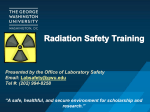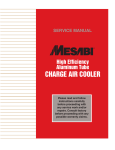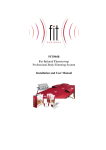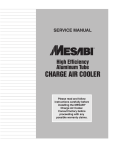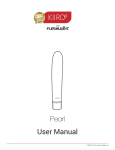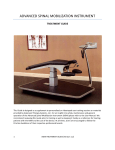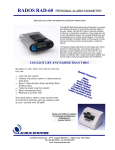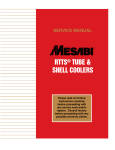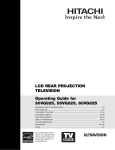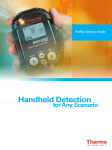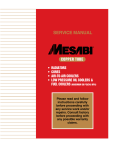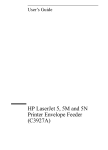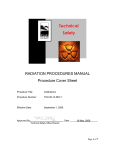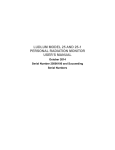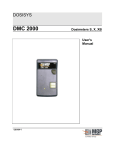Download Please sign in
Transcript
GWU Radiation Refresher Training Please sign in Training Refresher Topics • • • • • • • • License and authorization Ordering radioactive material & inventory Waste Safe radioactive material use Monthly surveys ALARA Security Exposure response Radiation Exposure Small quantities of radioactive materials are used at GWU. Only very small radiation doses are expected for the users of radiation/radioactive material. No doses are expected for any other personnel. No biological effects are expected at these low dose levels. License • GWU is licensed to use radioactive material (RAM) by the Nuclear Regulatory Commission (NRC). • Our license is a “Broad Scope License” and allows us to use a wide range of isotopes within activity limits, providing that we conduct our Radiation Safety program in accordance with our license application as submitted to the NRC as well as comply with Federal regulations. Some important elements of the program are: • Radiation Safety Officer (RSO) • Radiation Safety Committee (RSC) • Authorized User (AU) • Training with examination • Document RAM use and waste • Security of RAM • Conduct periodic surveys Authorization • Authorized Users - approved by the Radiation Safety Committee (RSC) • Only AUs or those under them can use RAM • AU - principal investigator with the responsibility for ensuring that his/her workers follow procedures. • Each AU authorization is specific for each isotope, activity limits (on hand and annual), rooms for use. • All users of RAM must be trained and pass an examination as well as demonstrate competence in handling RAM. • Authorizations are renewed by the AU and approved by the RSO annually and include a physical inventory of RAM on hand. Authorization cont. • Only rooms on the authorization can have RAM storage or use. These rooms must have: – Placard in hall – Caution sign on lab door • AU programs must have means to conduct contamination surveys. • AUs must maintain the radiation binder which contains at minimum: – AU guide – Utilization logs – Protocols – Reg guide 8.29 and 8.13 Hall Placard Authorization cont. • Renewals – annually you will be sent a renewal form to correct, sign and return to OLS. • Substantial changes to an authorization such as room change, new isotope, on-hand limit, etc. will need an amendment form (on the website) • New users – Study user manual & Perkin Elmer guide – Complete new user/dose eval form – Attend training & exam (Schedule as needed) • Almost everything you need is at the OLS website • If anything is amiss on the website, please contact Dan Hibbing ([email protected]) On the Web www.gwumc.edu/research/home.htm >> AU toolbox Ordering RAM • Radiation Safety receives quotes from vendors for RAM for agreed prices. • Your department places order through EAS Oracle or iBuy. OLS will approve the order if lab is authorized for product and with in limits (annual and on-hand) • Contact OLS if your lab needs to place an order differently than the above steps Ordering RAM (cont) • Proper ordering details: – Addressed to: Dan Hibbing/[PI] Ross Hall Recv-Loading Dock – Account: 54521- Radioactive Lab Supplies – DOT Hazard Class (7) – Supplier Item Number is included along with a description – Proper shipping charges – Questions need to be directing to OLS prior to order Inventory • Isotopes - received by a user and secured (locked) immediately. You will receive a utilization log sheet with the order (fridge or binder) • RAM used must be entered on the utilization log (fill in all blanks) • Stock vials must be kept stored in their container (pig) and it must be labeled with the 4 digit inventory #. • Inventory cannot be given to other labs without OLS approval. Please contact Dan Hibbing if RAM needs to be moved between labs. Waste • Dry Solid Material (DSM) • Segregate by isotope in separate boxes (“hat box”), labeled correctly. • All waste added is entered on the DSM log on waste box. • Call for pickup when full (or 1 yr) • NO STOCK VIALS (even if empty). • NO LIQUIDS • NO HAZ MAT – ie: lead, mercury, chemicals • NO SHARPS OR BIOWASTE • NO FOOD Waste cont. • Liquid radioactive waste (non-hazardous waste) • Liquid waste - disposed of in a designated “Hot Sink” which must be marked with rad tape and have a sign posted. • Run large amounts of water before, during and after release. • Don’t splash. No contamination on bench around sink. Limit contamination in basin. • Estimate activity and record on the Hot Sink disposal log. Logs will be picked up periodically. • Must not exceed monthly disposal limits per isotope. • Must be sewer disposable: no hazardous waste (pH 5 - 9) • No liquid disposed direct from stock vial. Secondary containment for all radioactive liquids Waste cont. • Stock vials • To dispose of a stock vial call Radiation Safety. We will collect the vial, sign utilization log and give you a copy. • Do not discard vials in dry waste or pour remaining liquid in hot sink • Vials do not need to be decayed prior to pickup, contact OLS as soon as a vial is no longer needed. • Scintillation vials • 3H / 14C – If <50,000 cpm discard in “cold trash” waste. Update exempt vial disposal log. • All other hot vials must be placed upright in trays and labeled “Caution Radioactive Material”, isotope and estimate activity. Call for pickup or if large volumes expected. • Never discard vials with DSM waste. Hot Sink Sign RAM Use – work areas • RAM is only to be used in designated use areas - mark with radiation tape and use plastic backed absorbent paper. OLS will help delineate radiation areas from cold areas. • Any equipment where RAM is used or stored must be labeled ie: hoods, refrigerators, centrifuges, etc. RAM Use - surveying • As you work, survey your gloves to detect any contamination • The meter must always be on when working with RAM (if detectable) • When work is finished, benches, clothing, floors and other equipment should be surveyed to detect any contamination (Move the detector slowly) • Contamination: • > 2X background (meter) • > 150 cpm (wipe test) RAM Use - contamination • No contamination should be present outside of rad use areas. • If contamination is discovered, it should be cleaned up immediately. If you suspect contamination with 3H do wipe tests to survey.(35S or 14C may need wipe tests if low activity). RAM Use - contamination • Contamination inside radiation areas should be avoided. if discovered, clean as soon as work is complete (contaminated bench paper goes in DSM) • Small amounts of contamination may persist in work areas due to residual in equipment and may be unavoidable, but, must be below following levels when measured at the edge of the bench: • For 125I and 51Cr, using a 44-3 meter < 15000 cpm • For all other isotopes, using a GM meter < 1500 cpm • Dose rate limit at radiation area boundary is 0.5 mRem/hr. The above count rates are designed to keep doses well under this level. RAM Use – clean up • Contamination should be cleaned with bubbling spray such as Count-Off or Dow cleaner and paper towels. • Clean small areas at a time to avoid spreading any contamination • The area should be surveyed until no removable contamination is detected and discarded in DSM. • For more than incidental contamination, contact Radiation Safety for assistance and inform your AU. Mistakes will happen, but please get help. Safe Lab Practices • No eating, drinking, chewing gum etc in rad labs. • Never store food in rad storage areas, e.g. fridges. • Wash your hands promptly after handling any radioactive material. • Wear prescribed dosimeters. Dosimetry will not be prescribed when using tritium or extremely low doses expected. Personal Protective Equipment • Lab coat, disposable gloves and eye protection are required at all times. • Refer to authorization for specific requirements. • Do not wear baggy clothing, dangling jewelry, and cinch up loose long hair. • Legs must be covered and close toed shoes worn. Survey Meters Survey Meter w/ “pancake” GM detector Survey Meter w/ “end window” Geiger Muller GM detector Survey Meter w/ low energy gamma detector Ludlum 44-3 (125I, 51Cr, γ emitters) Survey Meters • Will not detect 3H (must use liquid scintillation to detect) • Are calibrated annually • Always check batteries to make sure they are in range as well as a physical check for damage. • Check the meter before each use by holding the probe against the check source. It should closely match calibration number on sticker. • A properly working GM meter has a background count rate of about 40-60 cpm. If it is not working contact OLS. Wipe Surveys • Used to determine if contamination is removable or fixed • Use 2.5 cm filter disc for LSC counting • Cover at least 100 cm2 of surface • Limits are based on 100 cm2 • Only way to detect 3H • For instructions on LSC counting, contact OLS or discuss with your PI Monthly surveys • A documented survey must be done each month when RAM was used with a meter and LSC swipes • Labs not using that month still must fill out a survey form • Therefore, there must be a sheet in the binder for every month of the year Monthly surveys • Take swipes of areas that are likely to have contamination such: hot sink, rad bench, rad area floors, door handles, floors near exit, equipment such as fridges and centrifuges. • Be sure to differ swipe locations from month to month ALARA As low as reasonably achievable (ALARA) – To minimize dose from external sources there are 3 primary methods: •Time •Distance •Shielding As Low As Reasonably Achievable (ALARA) • TIME - minimize the time spent receiving a dose • Plan you experiment and have all materials present before introducing RAM • Work methodically and at a good pace but don’t rush as this could cause accidents • Put stocks away soon after you are finished with them As Low As Reasonably Achievable (ALARA) • DISTANCE – keep as much distance between you and the source as possible • Doubling the distance from the source reduces the dose to one quarter • Set stock vials away from you when not handling them • Use tongs or tweezers to hold containers when feasible • Store waste in a low traffic area Inverse Square Law Dose Rate = 1 Dose Rate = 1/16 Dose Rate = 1/4 Distance = 1 Distance = 2 Distance = 4 As Low As Reasonably Achievable (ALARA) • SHIELDING – block radiation with a suitable material • Use an appropriate material at an adequate thickness to stop radiation. • Protects your body when working and protects those nearby from stocks or waste. High energy beta emitters (32P) –plexiglass (1cm) Gamma emitters (125I) – lead (sheets, foil or bricks) • Put vials back in protective packaging, such as plastic vials or lead foil, when finished. Security • Radioactive material is only to be used by those who are authorized by OLS. • RAM must never be left unattended, rooms must be locked and RAM must be locked in a fridge or cabinet. • Access must be limited to those who have a need to be there and all must wear identification • If someone is not wearing a badge ask if you can help them and direct them and escort them to the front desk for assistance. • Report any suspicious activity to security Procedure if Individuals are Contaminated If you find personnel contamination, take the following steps: 1. Have someone call OLS, 4-2630 2. Remove clothing that is contaminated (take measures for modesty if someone must disrobe) 3. Start washing area. 4. Complete a GWU incident form and submit it to MC safety. Medical treatment is available if necessary Decontamination To decontaminate skin: 1. If a large area, wash with mild soap and water right in the sink. 2. If only a small area, use a wet towel and mild soap to start decontaminating. 3. Check towel with meter. 4. Avoid spreading the contamination to other areas. Decontamination Don’t scrub contaminated area! Your skin turning red is a way of letting you know to stop DO NOT USE ANYTHING EXCEPT MILD SOAP! Emergency Contacts Office of Laboratory Safety 4-2630 Radiation Safety Officer 682-551-2424 Also check “NRC Notice to Employees” posted in the radiation use and storage areas More Information • Refer to the NRC REGULATORY GUIDE 8.29 on "Instruction Concerning Risks from Occupational Radiation Exposure," and NRC REGULATORY GUIDE 8.13 on "Instruction Concerning Prenatal Radiation Exposure". These documents are available from the Office of Laboratory Safety (call 202994-2630). • The OLS will provide confidential advice to those who are pregnant. A pregnant person need not declare their pregnancy in order to receive this advice. Questions?











































